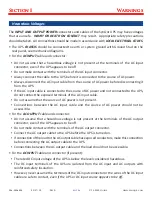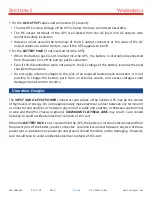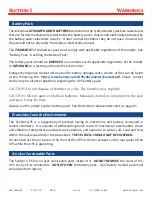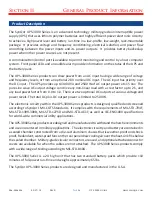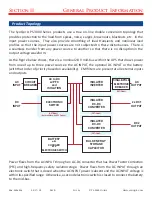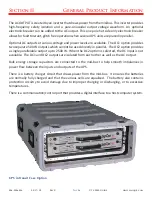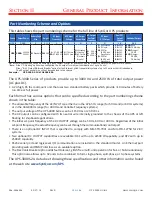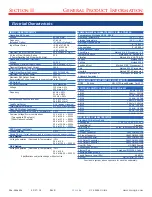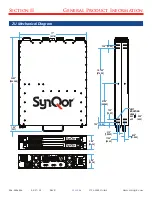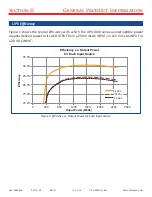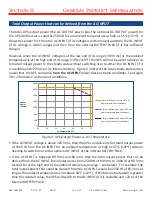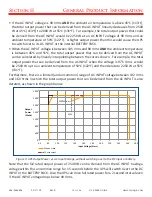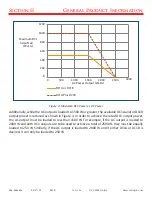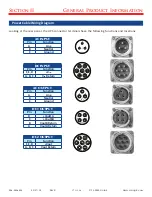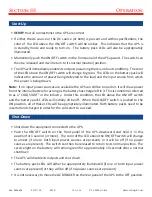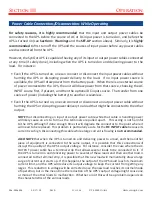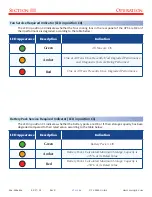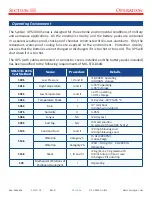
Section II
General Product Information
006-0006504 02/27/18
Rev R
18 of 56
UPS-3000 Guide
www.synqor.com
Power Cable Wire Size
SynQor recommends the following cables for use with the UPS-3000 Series:
AC Input:
SYN-9105 UPS connection to Hardwire Termination, 10’
AC Output:
SYN-9135 UPS connection to Hardwire Termination, 10’
DC Input:
SYN-9155 UPS connection to Hardwire Termination, 10’
DC1 Output:
SYN-9173 UPS connection to Hardwire Termination, 10’
DC2 Output:
SYN-9178 UPS connection to Hardwire Termination, 10’
Other options may be available. Contact info@synqor.com or visit the website: www.synqor.com for more
information. If it is necessary to develop custom cables for your application, please read through the following
section for some important considerations. Damage caused by improper wiring of cables will not be covered
under SynQor’s warranty.
Both the input and output cables of the UPS carry substantial current, and since the wires in these cables have
resistance the current flowing through them causes a voltage drop from one end of the cable to the other. In
other words, the voltage across the cable at its downstream end is smaller than the voltage across the cable at its
upstream end. Mathematically, the amount that the voltage drops is equal to the resistance of the cable’s wire
multiplied by the current flowing through the wire. It is therefore important to make sure that the resistance of
the cable’s wire is small enough to keep this voltage drop to an acceptably small value.
While this is an issue for all of the power cables, it is particularly important for the DC Input, DC1 Output and
DC2 Output cables because the current flowing through it is very high (as high as 124 A for the UPS-3000 Series)
and the voltage across it is already relatively small (as low as 22 V). In fact, a common problem that arises
(when the DC INPUT cable has too small a wire) is that the voltage seen at the DC INPUT of the UPS falls below
the minimum specified value of 22 V even though the voltage at the source of the DC power is greater than
22 V. Under this condition the UPS will switch to the internal battery pack for its power source even though the
voltage at the DC source of power appears to be available and at a proper level.
The resistance of a wire depends directly on its length. A wire twice as long as another will have twice the
resistance, holding all other things constant. The resistance also depends on the reciprocal of the cross-sectional
area of the wire, which in turn depends on the square of the wire’s diameter. A wire with half the diameter of
another will therefore have four times the resistance, holding all other things constant.
Therefore, the longer a cable is, the more important it is that the wire’s diameter be large. Alternatively, a cable
can have multiple pairs of wires to achieve a larger “effective wire diameter”. This second approach gives a more
flexible cable. For 10 ft long cables, SynQor recommends that for the UPS-3000 Series:
• The AC INPUT cable have 3 wires (one for the ground) of 8 AWG
• The DC INPUT cable have 6 wires (three for each connection) of 8 AWG
• The AC OUTPUT cable have 3 wires (one for ground) of 10 AWG
• The DC1 OUTPUT cable have 4 wires (two for each connection) of 10 AWG
• The DC2 OUTPUT cable have 6 wires (three for each connection) of 8 AWG
Additional details about the effects of a resistance-related voltage drop are included in “Trouble-Shooting
Guide - Cable wire resistance is too high”.

